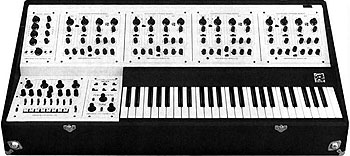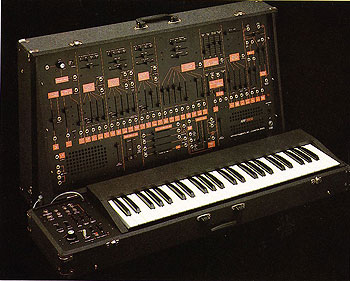Way Out Sounds: Roger Joseph Manning, Jr. and Synths That Defined The Seventies
Published on December 5th, 2011 in: Dancing Ourselves Into The Tomb, Issues, Music |
Oberheim Four-Voice
My favorite synthesizer is the Oberheim four-voice, which came out in 1975. It’s really just a personal preference. It couldn’t necessarily do any more or less than its competitors of the day, but I’ve always found its basic tone to be the heaviest . . . the richest among the synthesizers. You’ll hear a lot of people throw the word “analog” around because they prefer the way the sonics hit their ears and their body, how they are affected internally by an analog synth’s sound waves versus how digital sounds affect the human body. Of all the analog synths, for some reason, I prefer the Oberheim’s tone and sound generating qualities above all the others . . . to this day. They’re just fantastic! You can hear the Oberheim on Pat Metheny’s records with Lyle Mays, most notably on The Pat Metheny Group’s self-titled debut album. I know Supertramp used the Oberheim four-voice on the album Breakfast in America, Patrick Moraz of the band Yes also used the Oberheim as did [jazz artist] Chick Corea. In the Doobie Brothers’ “What a Fool Believes,” the Oberheim four-voice is the primary synthesizer in that song.

The ARP 2600
ARP was another unique version of what was going on at the time. They were one of the first companies to have a miniaturized modular system. The benefits of the modular system are that you have more options to create sound. It can be a little more confusing; you have to be more studied in sound construction and just basic synthesis, but once you have the basics, you could do some extraordinary things! The ARP 2600 was the model that a lot of people used in progressive rock, in jazz, and even in film scores because it could generate sound effects very easily. It was very fun to create nonmusical sounds on them. But, you know Joe Zawinul of the group Weather Report, he used two of them at the same time and made beautiful lyrical, musical sounds with the ARP 2600. Stevie Wonder used the ARP 2600 a lot, especially on the album Music of My Mind (1972). However, one of the most popular rock/pop pieces to use the ARP so extensively is the intro to Elton John’s “Love Lies Bleeding” performed by David Henschel; it’s all ARP 2600.
Popshifter asks: What elements would you take from each of these synthesizers to create the quintessential Roger Manning Jr. synth?
That’s a good question! I would take the general oscillators, the tone generators from the Oberheims, and I’d put them through the Moog filters and then I would make them all very easily patchable with cables and simplified in the way the ARP did with their 2600 modular. And then of course I’d have MIDI on it so I could program and store sounds. I’d definitely go with that formula!
Many thanks to Roger for taking the time to answer all our keyboard questions! For more on Roger, check out our various Popshifter pieces about him as well as his website.
Pages: 1 2
One Response to “Way Out Sounds: Roger Joseph Manning, Jr. and Synths That Defined The Seventies”
December 6th, 2011 at 4:44 pm
Wonderful article!
Time limit is exhausted. Please reload the CAPTCHA.